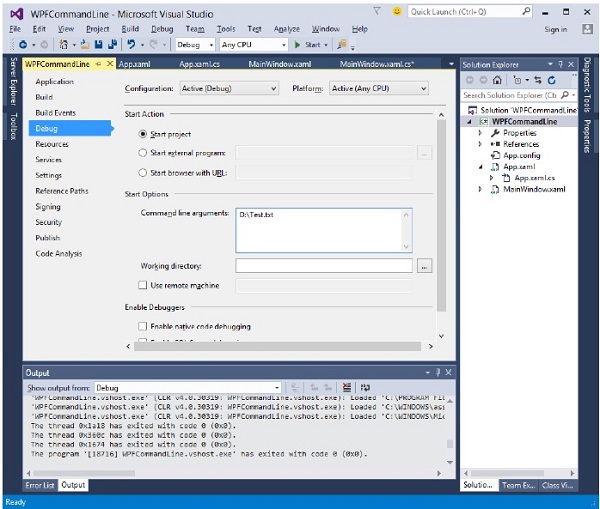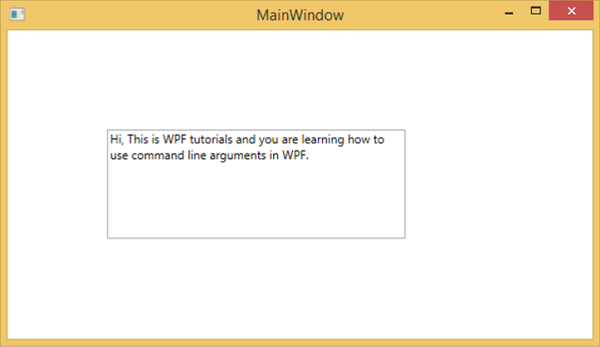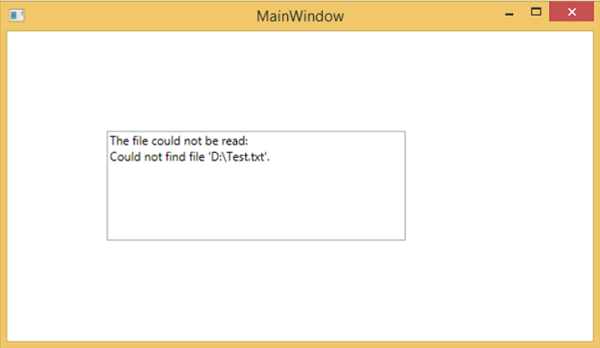WPF-コマンドライン
コマンドライン引数は、ユーザーが実行時に一連のパラメーターまたは値をWPFアプリケーションに渡すことができるメカニズムです。これらの引数は、外部からアプリケーションを制御するために非常に重要です。たとえば、コマンドプロンプトからWord文書を開きたい場合は、次のコマンドを使用できます。C:\> start winword word1.docx」と開きます word1.docx 資料。
コマンドライン引数は、スタートアップ関数で処理されます。以下は、コマンドライン引数をWPFアプリケーションに渡す方法を示す簡単な例です。名前を付けて新しいWPFアプリケーションを作成しましょうWPFCommandLine。
1つのテキストボックスをツールボックスからデザインウィンドウにドラッグします。
この例では、txtファイルのパスをコマンドラインパラメーターとしてアプリケーションに渡します。
プログラムはtxtファイルを読み取り、テキストボックスにすべてのテキストを書き込みます。
次のXAMLコードは、テキストボックスを作成し、いくつかのプロパティで初期化します。
<Window x:Class = "WPFCommandLine.MainWindow"
xmlns = "http://schemas.microsoft.com/winfx/2006/xaml/presentation"
xmlns:x = "http://schemas.microsoft.com/winfx/2006/xaml"
xmlns:d = "http://schemas.microsoft.com/expression/blend/2008"
xmlns:mc = "http://schemas.openxmlformats.org/markup-compatibility/2006"
xmlns:local = "clr-namespace:WPFCommandLine"
mc:Ignorable = "d" Title = "MainWindow" Height = "350" Width = "525">
<Grid>
<TextBox x:Name = "textBox" HorizontalAlignment = "Left"
Height = "180" Margin = "100" TextWrapping = "Wrap"
VerticalAlignment = "Top" Width = "300"/>
</Grid>
</Window>- 次に、以下に示すように、App.xamlファイルでStartupイベントをサブスクライブします。
<Application x:Class = "WPFCommandLine.App"
xmlns = "http://schemas.microsoft.com/winfx/2006/xaml/presentation"
xmlns:x = "http://schemas.microsoft.com/winfx/2006/xaml"
xmlns:local = "clr-namespace:WPFCommandLine"
StartupUri = "MainWindow.xaml" Startup = "app_Startup">
<Application.Resources>
</Application.Resources>
</Application>以下に示すのは、コマンドライン引数を取得するApp.xaml.csのapp_Startupイベントの実装です。
using System.Windows;
namespace WPFCommandLine {
/// <summary>
/// Interaction logic for App.xaml
/// </summary>
public partial class App : Application {
public static string[] Args;
void app_Startup(object sender, StartupEventArgs e) {
// If no command line arguments were provided, don't process them
if (e.Args.Length == 0) return;
if (e.Args.Length > 0) {
Args = e.Args;
}
}
}
}これで、MainWindowクラスで、プログラムはtxtファイルを開き、すべてのテキストをテキストボックスに書き込みます。
エラーが見つかった場合、プログラムはテキストボックスにエラーメッセージを表示します。
using System;
using System.IO;
using System.Windows;
namespace WPFCommandLine {
public partial class MainWindow : Window {
public MainWindow() {
InitializeComponent();
String[] args = App.Args;
try {
// Open the text file using a stream reader.
using (StreamReader sr = new StreamReader(args[0])) {
// Read the stream to a string, and write
// the string to the text box
String line = sr.ReadToEnd();
textBox.AppendText(line.ToString());
textBox.AppendText("\n");
}
}
catch (Exception e) {
textBox.AppendText("The file could not be read:");
textBox.AppendText("\n");
textBox.AppendText(e.Message);
}
}
}
}上記のコードをコンパイルして実行すると、このプログラムにはコマンドライン引数が必要なため、テキストボックスのある空白のウィンドウが生成されます。そのため、Visual Studioは、コマンドラインパラメーターを使用してアプリケーションを実行する簡単な方法を提供します。
ソリューションエクスプローラーでWPFプロジェクトを右クリックし、プロパティを選択すると、次のウィンドウが表示されます。

[デバッグ]オプションを選択し、コマンドライン引数にファイルパスを書き込みます。
Test.txtを使用してtxtファイルを作成し、そのファイルにテキストを書き込んで、任意の場所に保存します。この場合、txtファイルは「D:\」ハードドライブ。
プロジェクトに変更を保存し、今すぐアプリケーションをコンパイルして実行します。プログラムがText.txtファイルから読み取るTextBoxにテキストが表示されます。

それでは、マシンのファイル名をから変更してみましょう。 Test.txt に Test1.txt プログラムを再度実行すると、テキストボックスにそのエラーメッセージが表示されます。

上記のコードを実行し、すべての手順に従ってアプリケーションを正常に実行することをお勧めします。